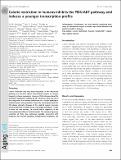Calorie restriction in humans inhibits the PI3K/AKT pathway and induces a younger transcription profile
Author(s)
Mercken, Evi M.; Crosby, Seth D.; Lamming, Dudley W.; JeBailey, Lellean; Krzysik-Walker, Susan; Villareal, Dennis T.; Capri, Miriam; Franceschi, Claudio; Zhang, Yongqing; Becker, Kevin; de Cabo, Rafael; Fontana, Luigi; Sabatini, David; ... Show more Show less
DownloadSabatini_Calorie restriction.pdf (443.7Kb)
PUBLISHER_CC
Publisher with Creative Commons License
Creative Commons Attribution
Terms of use
Metadata
Show full item recordAbstract
Caloric restriction (CR) and down-regulation of the insulin/IGF pathway are the most robust interventions known to increase longevity in lower organisms. However, little is known about the molecular adaptations induced by CR in humans. Here, we report that long-term CR in humans inhibits the IGF-1/insulin pathway in skeletal muscle, a key metabolic tissue. We also demonstrate that CR induces dramatic changes of the skeletal muscle transcriptional profile that resemble those of younger individuals. Finally, in both rats and humans, CR evoked similar responses in the transcriptional profiles of skeletal muscle. This common signature consisted of three key pathways typically associated with longevity: IGF-1/insulin signaling, mitochondrial biogenesis, and inflammation. Furthermore, our data identify promising pathways for therapeutic targets to combat age-related diseases and promote health in humans.
Date issued
2013-06Department
Massachusetts Institute of Technology. Department of Biology; Whitehead Institute for Biomedical Research; Koch Institute for Integrative Cancer Research at MITJournal
Aging Cell
Publisher
Wiley Blackwell
Citation
Mercken, Evi M., Seth D. Crosby, Dudley W. Lamming, Lellean JeBailey, Susan Krzysik-Walker, Dennis T. Villareal, Miriam Capri, et al. “Calorie Restriction in Humans Inhibits the PI3K/AKT Pathway and Induces a Younger Transcription Profile.” Aging Cell 12, no. 4 (June 5, 2013): 645–651. © 2013 John Wiley & Sons Ltd and the Anatomical Society
Version: Final published version
ISSN
14749718
1474-9728